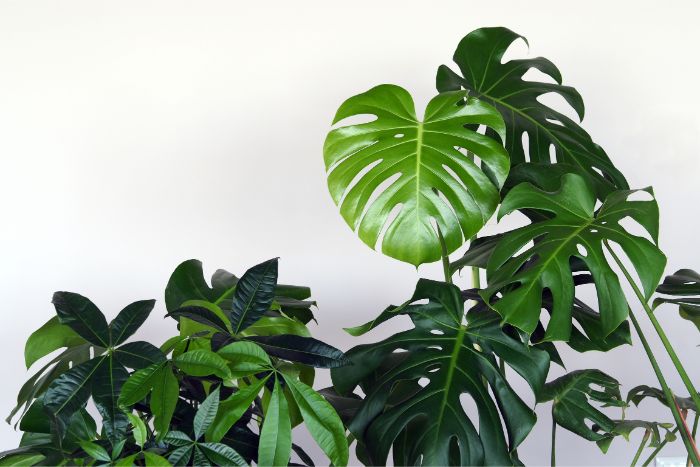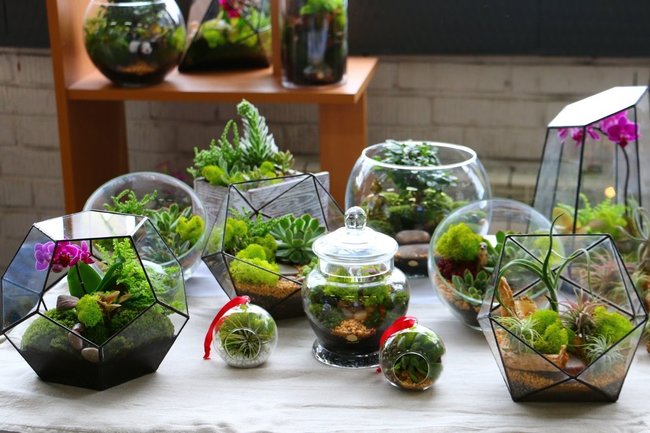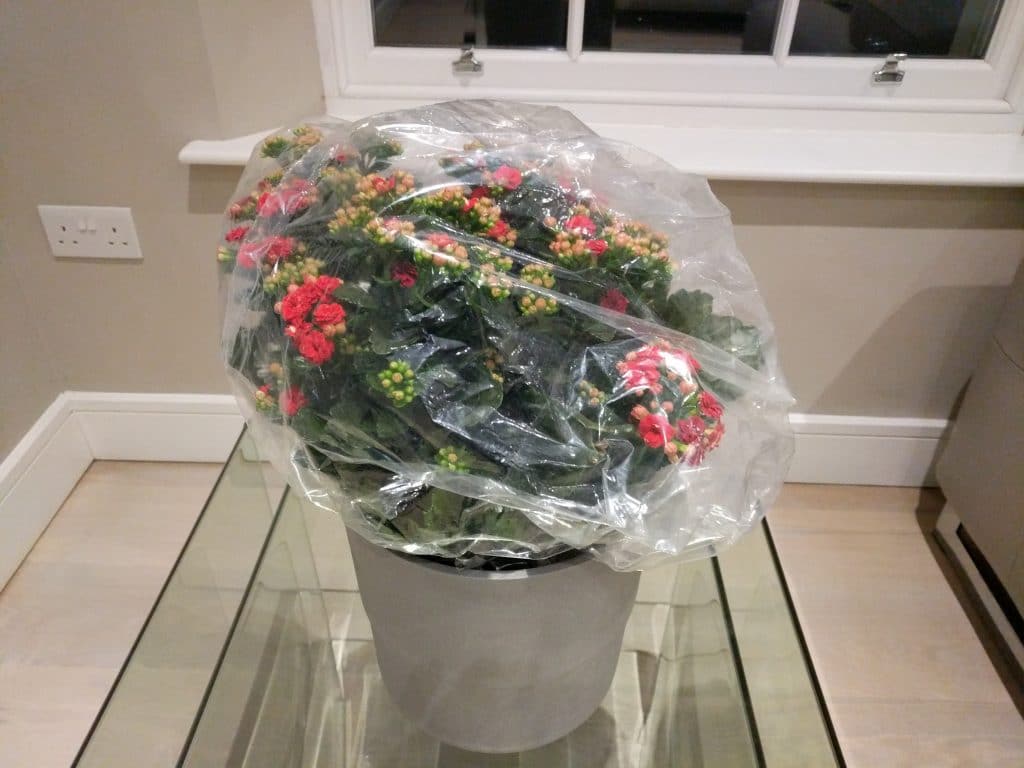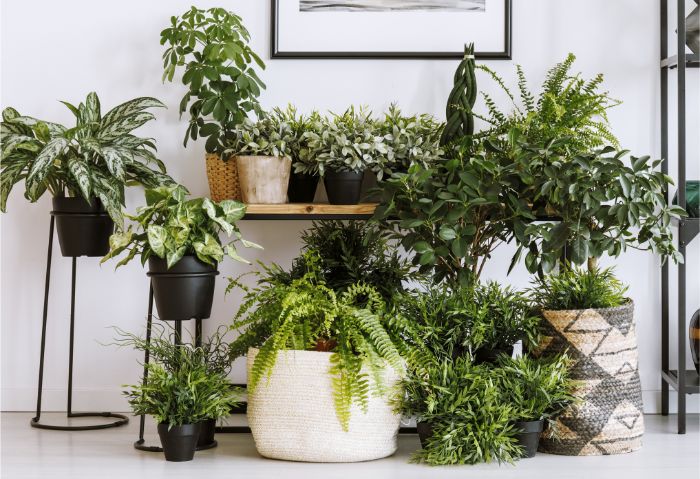Indoor plants often benefit from humidity levels higher than our homes naturally provide. This can be a particular problem in winter when we have the heating on and the windows shut. This article will show you some great ways to increase humidity for indoor plants to create a more pleasant environment for them and for you.
How to increase humidity for indoor plants: Increase humidity for your houseplants by grouping your plants together, misting them, using a humidifier or using a humidity tray. Locating your plants in a bathroom or growing them in a terrarium or indoor greenhouse can also really help.
There are so many options to increase humidity for indoor plants. It helps your houseplants thrive and can be beneficial for you also, as moderate humidity levels are much more comfortable than low humidity. Read on and I’ll explain why increased humidity is great for your houseplants and how to achieve this.
10 Great Ways To Increase Humidity For Indoor Plants
These 10 simple options to increase humidity for houseplants are easy to set up and will work whether you have a single houseplant or a house full of plants.
1. Group Your Plants

Plants lose water from their leaves through tiny pores called stomata, in a process called transpiration. This water vapor enters the air in the immediate vicinity of the plant, increasing local humidity. By grouping your plants together, the amount of transpiration increases, and humidity levels will improve significantly.
Have you ever walked into a garden center and felt the humidity in the air. Well, this is partly due to the transpiration of all the plants in close proximity. A great, natural way to increase humidity.
The drawback here is that you need to have lots of plants in one area. Often this isn’t practical or desirable. What if you don’t want to have 20 plants in your kitchen, but just really like one or two to add a bit of greenery.
2. Mist Your Houseplants
The first option many people think of to increase humidity for their indoor plants is to mist them. Using a simple spray bottle, you can spray the air around your houseplants and spray directly onto the plants.
Some of the moisture will vaporize directly, increasing humidity, while most of it will land on the leaves of your plants and surrounding surfaces. This moisture will slowly evaporate, providing an increase in local humidity for several hours.
This method is quick and easy, but it will only provide an increase in humidity levels for a few hours, so you will need to repeat the process as needed. In addition, much of the water will end up on the plant foliage which can increase the risk of fungal and bacterial disease, particularly in susceptible plants.
Misting in the morning ensures that all excess moisture has time to evaporate during the day, before the cool of nighttime. This minimizes the risk of your houseplants developing fungal or bacterial disease.
Overall, to make any meaningful impact on humidity levels, you need to mist several times per day, which is fairly impractical for most people.
3. Use A Humidifier
The ultimate no fuss option to increase humidity for your houseplants is to get an electric humidifier. These can be fairly small and discrete and can be turned on or off to create the perfect level of humidity in a room for you and your plants.
With some humidifiers, you can even set them to maintain a particular humidity level, or to operate only at certain times of the day.
Using a humidifier isn’t just for the plants in your home, but there are benefits for you and your family too. I tend to get really dry skin and hair in the winter, when my central heating dries the air in my home like crazy.
Having a humidifer running makes things so much more comfortable and my plants like it too.
4. Put Houseplants In Your Bathroom
Think of the most humid room in your house, and most people will think of their bathroom. Bathrooms are a great place for houseplants generally, and plants which need high humidity levels will thrive in these conditions.
The wet environment created by sinks, baths and showers means there is usually some area of your bathroom that is in the process of drying during the day. Even wet towels are a significant source of moisture entering the air.
Phalaenopsis Orchids, Bromeliads, Ferns and Peace Lilies are great choices for your bathroom. Click on the links to learn more about caring for each of these houseplants.
5. Use A Pebble Tray
A pebble tray is a really simple way to increase local humidity for one or a small number of plants in an otherwise arid location. All you need is a drip tray that is about twice the diameter of the base of the plant pot, or ideally a bit larger.
It should be at least an inch deep to ensure that the water does not evaporate too quickly. Scatter some pebbles that are of roughly of equal size on the base of the tray and fill the tray with water to just below the top of the pebbles.
Place your houseplant pot on top of the pebbles so that it rests securely, without the base of the pot being in water. This will prevent the soil from absorbing the water and the roots becoming waterlogged.
The water will slowly evaporate into the air around your plant, increasing local humidity, while not significantly impacting the humidity level of the rest of your house.
The main drawback of this method is that there will be a constant pool of standing water around your houseplant. This can increase the risk of fungal or bacterial disease developing in your plants and can sometimes attract pests.
However, as a quick, simple solution, that needs minimal maintenance other than to top up the pebble tray when getting low, it’s a great option.
6. Give Them A Bath Or Shower
If you want to get two jobs done in one go, you can put houseplants in your bath or shower and give them a rinse down. This not only cleans the leaves, which is a good thing to do to keep your houseplants in top shape, but drenching the foliage and soil of your plants will lead to increased evaporation and local humidity over the next few days.
7. Use A Terrarium

Terrariums are such fun to design and build and it is no wonder they have become very popular in recent years. They can either be open or closed, providing moderate or very high humidity levels within their respective micro-climates.
Closed terrariums provide exceptionally high humidity levels, and won’t be suitable for all houseplants, but you certainly won’t need to worry about insufficient humidity, as the air will be near fully saturated with water vapor in this environment.
Open terrariums in contrast have a large opening to let air from outside the terrarium circulate freely with the inside of the terrarium. However, the glass walls will trap a fair amount of moisture in the air and reduce ventilation, which will increase humidity levels. Read more about how terrariums work here.
8. The Two Pot Method
The two pot method is a discrete way to increase humidity levels for an individual houseplant, without having to compromise the aesthetics or location of your plant.
Put your hosueplant pot into a pot that is 1-2 inches in diameter larger than the inner pot. Fill the gap with spaghnum moss and soak this with water. The moss will hold onto the water and dry out slowly over the space of a few days, releasing the water vapor into the air around your plants.
With this method, it is best to make sure the inner and outer pots both have drainage holes, to prevent water building up at the base of the outer pot, which could potentially cause root rot for your plant.
9. Dry Clothes In The Same Room As Your Houseplants
I’m sure I’m not the only one who struggles to find space to dry clothes at home. And yet your wet laundry is a great source of water vapor that your plants will love you for.
Just set up a drying rack near your houseplants or move your houseplants into the room you dry clothes in. The water evaporating from your clothes will increase the humidity level in the air and your plants can benefit.
10. Cover Your Plants With Plastic

While not the most attractive way to increase humidity for indoor plants, covering a houseplant with a clear plastic bag will create a highly humid environment for your plant. This can be particularly useful for helping a very sensitive plant through an arid winter indoors.
You can put a number of wooden stakes into the houseplant pot to prop the plastic up off the majority of the foliage. Keep an eye out for excessive condensation forming on the sides of the bag and open it up from time to time if you see this.
In addition, because this creates an environment like a little greenhouse, things can get very hot if you leave your plant in direct sunlight. Ensure your plant is kept in indirect light to prevent excessively high temperatures.
What Are The Signs Your Plants Need Higher Humidity?
After all this talk of increasing humidity levels for your indoor plants, I suppose it would be good to explain why many plants need higher humidity levels.
Many indoor plants originate from tropical locations where they live beneath the forest canopy. These plants thrive in warmer temperatures and lower light conditions, which is why they are so suitable as houseplants.
However, another constant of this climate is the higher humidity levels that are found. Plants taken out of their natural environment and placed in arid indoor conditions can soon show signs of stress.
If you know what to look for you can adjust the conditions and help your plants thrive. Here are the 8 most common signs your houseplants need higher humidity levels.
Brown Leaf Tips And Edges: Most moisture from a plant is lost through the leaves. In arid conditions, the rate of transpiration and evaporation will be higher. The delicate edges of the leaves are most sensitive and can easily suffer and turn brown in low humidity conditions. Brown leaf tips is a common problem for houseplants. Low humidity and watering problems are the two most common causes.
Yellow Leaves: Yellow leaves are a sign of plant stress that can be due to multiple reasons. Seeing a rapid increase in the number of yellow leaves on your plant should prompt you to review all care, including humidity levels.
Crispy, Dry Leaves: Low humidity levels cause excessive drying of the leaves and sometimes they are unable to remain sufficiently hydrated and they will become crispy and dry. This is a warning sign and needs to be fixed fairly rapidly.
Buds Drop Before Opening: The buds and flowers of most plants are the most sensitive to low humidity levels. When I grow flowering houseplants, seeing new buds and flowers is the most exciting and rewarding part of the growth cycle. Seeing buds dropping is so disappointing. Low humidity is a common cause, so think about this if you see it happening.
Buds Fail To Develop: If plants are stressed, many will refuse to flower, and the stress caused by low humidity can prevent your houseplants flowering in the first place.
This isn’t always the case, as there are plants where stress causes the plants to panic and rush to produce flowers when they may not otherwise have done. While this can be nice, I’ve had sad experiences where a stressed orchid blooms wonderfully before it’s health takes a major nosedive.
Flowers Wilt Soon After Opening: Dry air causes increased evaporation and water loss, and you may find your blooms start to wilt much quicker in low humidity.
Wilting Foliage: Generalized wilting of the foliage is often down to dehydration, but can be due to low humidity alone, even in the presence of adequately damp soil.
Higher Water Requirements: You may notice your houseplants have higher water requirements in low humidity conditions. As the rate of transpiration and evaporation is higher, more water is needed to keep the plant in good health.
What Is The Best Humidity Level For Plants?
Most houseplants will thrive at humidity levels of 50-60%. If you can achieve these humidity levels, most plants will successfully adapt and remain healthy.
There are a number of houseplants which require very high humidity levels to thrive and a few, but not many which do far better in very arid conditions.
Is Too Much Humidity Bad For Plants?
The main problem is disease. Excessively high humidity levels for the wrong type of plant can be disastrous, greatly increasing the risk of bacterial and fungal disease.
Many bacteria and fungi thrive and multiply rapidly in high humidity conditions, particularly when ventilation is poor. This can cause disease to set in quickly and rapidly kill your houseplants.
If your houseplants are growing in very humid conditions, you should ensure that these are the ideal conditions for the particular plant. In addition, you should ensure that ventilation is reasonable, as moving air will greatly decrease the risk of disease.
Obviously, you don’t want a wind blowing through your house, but opening a window from time to time, or using an electric fan if you are concerned can prevent a lot of problems.
Do Houseplants Increase Humidity?
Houseplants release water vapor into the air from stomata on their leaves. This will increase local humidity where they are growing. So if you are struggling with low humidity levels in your house, a very good option is actually to get some houseplants.
Low Humidity Houseplants
If you don’t like the idea of increasing humidity levels in your home, or if you prefer low humidity conditions, you can still enjoy the benefits of growing indoor plants. The following houseplants will thrive in low humidity conditions
- Aloe Vera
- Euphorbias
- Peperomia
- Rubber plants
- Cacti
- Jade Plant
- Crown Of Thorns
- Echeveria
- Ponytail Palm
High Humidity Houseplants
The following plants will do far better in high humidity conditions. If you’re keeping these plants, you should definitely monitor the humidity levels and use some of the techniques mentioned previously to help maintain good humidity levels.
- Rex Begonia
- Nerve Plant
- Peacock plant
- Orchids (some species)
- Alocasia
- Prayer Plant
- Lucky Bamboo
- Boston Fern
- Dieffenbachia
How To Check Indoor Humidity
If you keep houseplants at home, I would most definitely recommend picking up a cheap electric hygrometer and thermometer. These very affordable devices will give you a digital display of the current temperature and humidity level, as well as the high and low readings of the temperature and humidity level since the device was last reset.
Using these has allowed me to find the perfect location in my house for a number of my houseplants, and to take measures to adjust conditions where necessary. Here is the one I use (link to Amazon).
I hope you’ve found this article about increasing humidity for your houseplants useful. There are no shortage of ways to do this, but I would definitely recommend monitoring the humidity levels in your home and adjusting them whichever way is best for you and your plants.
If you want your houseplants to thrive and look amazing all year round, then please check out the rest of my articles. This site is packed full of great information to help you grow amazing houseplants and become a better gardener.


